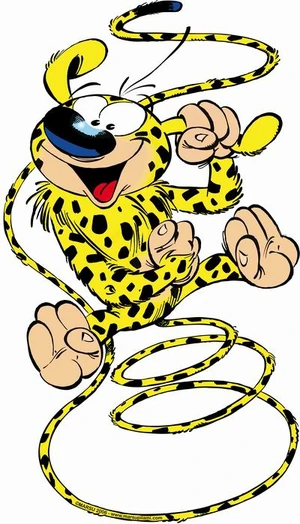| Marsupilami | |||
|---|---|---|---|

| |||
| Naming | |||
| Binomen | Marsupilamus fantasii | ||
| Morphology | |||
| Average height | 1 – 1.3 meters | ||
| Intelligence | |||
| Sentience | Sentient | ||
| Sapience | Semi-Sapient | ||
| Aggressivity | Low | ||
| Ecology | |||
| Habitat | Palombian Jungle | ||
| Diet | Omnivorous | ||
| Locomotion | Facultative biped; uses tail to move around in creative ways (as a spring, a propeller, etc.) | ||
| Reproduction | Oviparous | ||
| Status | EN | ||
| Behind the Scenes | |||
| Created by | André Franquin | ||

A Marsupilami family in its elaborate nest.
The Marsupilami is a bipedal arboreal monotreme native to the Palombian rainforests of South America. Its most noticeable feature is the absurdly elongated and slender tail, which can grow over six times its body length. More than just prehensile, the tail is extremely flexible, able to be bent and shaped into knots without sustaining damage; perhaps suggesting an internal structure rich in collagen, similar to that of the hagfish of deep oceans. The tail can be used for locomotion in a number of ways, including being used as a spring. Also renowned is the strength of the Marsupilami, far greater than what would be expected from an animal of its size. It is however a gentle and easy-going creature if not provoked. Its sharp intellect is demonstrated by the use of tools, making it possibly the most sophisticated of all monotremes.
Biology[]
The Marsupilami somewhat resembles a primate, with long forearms and relatively short legs, four digits on each paw (including opposable thumbs) and a rounded head featuring long, bended ears. The snout is large and so are the eyes, giving it keen senses which help it in moving through the treetops with enviable agility. It is covered in yellow fur with small black spots all over, although some individuals are born with other variations in color, including solid-black and solid-yellow. A patch of longer fur, resembling a mane, is present adorning the creature’s neck and shoulders. They are known for their distinct call: "Houba!" (by the males) or "Houbi!" (by the females); but are also able to mimic other sounds, including in some cases human speech. The Marsupilami is an omnivorous, its menu principally consisting of fruit and piranhas. [1]
An astute creature, the Marsupilami lives in small family units and builds elaborate nests in the canopy; made out of sticks, vegetation and ropes, and stuffed with bird feathers and decorated with flowers. This nest is also built in such way that allows it to lock closed like an oyster in case of danger. The Marsupilamis appear to be monogamous and care for their offspring, which are born from red pear-shaped eggs camouflaged to resemble forest fruit (a peculiar form of camouflage at least, for one would imagine it would invite predators rather than evade them). Curiously, despite being born from eggs, the Marsupilami retains a clearly visible belly button. Some sources have suggested that this is rather a specialized organ which allows the parents to transmit information to their offspring when the later put their ears close to it. Whether the information is transmitted in the form of mechanical vibrations, chemicals or even telepathy is still unclear.
Notes[]
- Created by André Franquin in 1952, the Marsupilami first appeared in the Spirou magazine. In 1987, it got its own comic title and later became the basis for a Disney animated series, Marsupilami, in 1993. Previously, it had already appeared as a character in Disney's Raw Toonage. In 2012 it starred in the live action movie On the Trail of the Marsupilami. It also had a cameo appearance in Asterix and the Big Fight.
- In the Disney Adaptation, Marsupilami has given the ability to speak full sentence.
